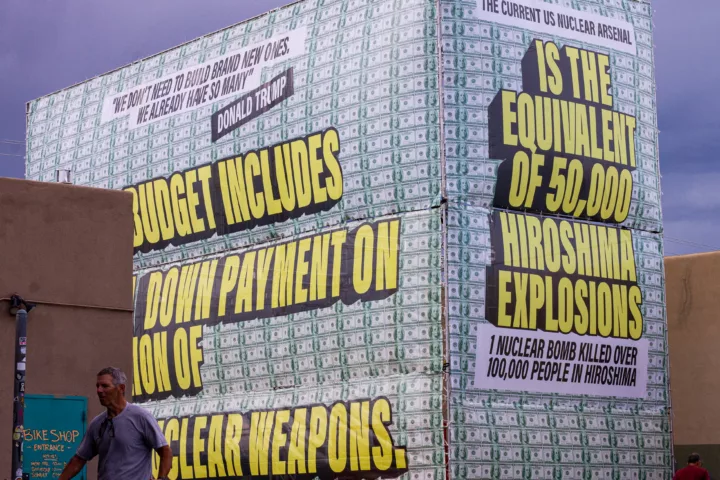FOR IMMEDIATE RELEASE, February 12, 2020
Contact: Jay Coghlan, Nuclear Watch NM, 505.989.7342, jay[at]nukewatch.org
Santa Fe, NM – The Trump Administration has released more budget information for fiscal year 2021 for the Department of Energy (DOE). * It states that proposed cleanup at the Los Alamos Lab is “Consistent with the priorities established with the New Mexico Environment Department in the 2016 Consent Order…” It then goes on to cut LANL cleanup by $100 million from $220 million in FY 2020 to $120 million requested for FY 2021. (Pages 52 and 55)
Early negotiations of NMED’s 2016 Consent Order were held by the former DOE head of Los Alamos cleanup and a LANL employee who became a New Mexico Environment Department (NMED) division director. After the 2016 Consent Order was signed both officials went to work for the same DOE contractor (Longnecker and Assoc.) who is now involved in both the LANL prime management and cleanup contracts.
Under the Gov. Martinez Administration, at the Lab’s request, NMED granted more than 150 extensions to cleanup milestones stipulated in a stringent, enforceable 2005 Consent Order. The NMED Secretary, who later resigned to become Executive Director of the New Mexico Oil and Gas Association, then turned around and claimed that the earlier Consent Order wasn’t working.
A crucial difference between the 2005 and 2016 Consent Orders is that the former Order was designed to make DOE and LANL get more cleanup money from Congress. In direct opposition, the 2016 Consent Order specifically states that DOE and NMED “shall meet to discuss the appropriation and any necessary revision to the forecast, e.g. DOE did not receive adequate appropriations from Congress…”
In other words, cleanup at LANL is to be held hostage to DOE funding, when DOE’s own track record makes clear that its #1 priority is expanded nuclear weapons production paid for in part by cutting cleanup, nonproliferation and renewable energy programs. That has now dramatically come to pass with a proposed 46% cut to LANL cleanup programs, which are critically needed to protect New Mexico’s precious water resources. The Lab use to claim that groundwater contamination was impossible, but we know now that our common groundwater aquifer is extensively contaminated from historical LANL operations.
It is LANL’s nuclear weapons research and production programs that contaminated our groundwater to begin with, and those programs are on the cusp of a dramatic expansion that will inevitably cause more contamination. Site-specific budget details are still lacking, but nation-wide nuclear weapons “Production Modernization” under DOE’s semi-autonomous National Nuclear Security Administration (NNSA) is slated for a huge 57% jump, up from $1.6 billion in FY 2020 to $2.5 billion requested for FY 2021. (P. 60) The #1 priority within Production Modernization is expanded plutonium pit bomb core production, with 30 or more pits per year at LANL and 50 or more plutonium pits per year at the Savannah River Site in South Carolina.
NNSA is steamrolling expanded plutonium pit production while claiming that a 2008 “programmatic environmental impact statement” meets the legal requirements for public review under the federal National Environmental Policy Act. This is despite the fact that that outdated review did not formally raise the previous production cap of 20 pits per year, did not consider simultaneous plutonium pit production at two different sites, did not resolve chronic nuclear safety problems at LANL, and did not seriously consider credible alternatives such as reusing existing pits for refurbished or new nuclear weapons. The U.S. already has at least 15,000 plutonium pits in storage and independent experts have concluded that plutonium pits have reliable lifetimes of at least a century, with no proscribed end date (the average age of existing pits in the active nuclear weapons stockpile is under 40 years old).
Further, no pit production is scheduled to maintain the safety and reliability of the existing, extensively tested nuclear weapons stockpile. Instead, future production will be for speculative new-design nuclear weapons with heavily modified pit designs. This could actually degrade national security given that the reliability of future pits cannot be full-scale tested given the global nuclear weapons testing moratorium, or, perhaps worse, push the U.S. back into nuclear weapons testing with severe international proliferation consequences.
Jay Coghlan, Nuclear Watch Director, commented, “There is a clear tradeoff between funding for cleanup and funding for more unnecessary nuclear weapons. It’s time for our New Mexico congressional delegation to pick which side they’re on. Are they for permanently protecting our environment and water resources while creating hundreds of high-paying cleanup jobs? Or are they on the side of just shoveling more money to the nuclear weapons labs so we can have a new nuclear arms race?”
# # #
* All budget numbers are from the Department of Energy’s FY 2021 Congressional Budget Request, Budget in Brief, https://www.energy.gov/sites/prod/files/2020/02/f71/doe-fy2021-budget-in-brief_0.pdf
Listed page numbers are from that document. Please note that to date DOE has failed to release detailed budgets as required by law.

